|
"McCormick was not
only one of the first to successfully flute points, but also one of the
first to use heat treatment."-------2004, John
C. Whittaker, "American Flintknappers," p. 49.
"He (Marvin McCormick)
told me (Charley Shewey)
he was taught to knap when he was eight years old and he made 14 (points)
a day, 5 days a week."--------1998, Dave
Waldorf, "An Interview With Charley Shewey," Chips, Vol. 10, #3,
p. 12.
"Marvin McCormick was an early
maker (knapper) and seller of arrowheads, and most knappers and
collectors know his name."-------2008, Tony
Baker, "Marvin McCormick, The First modern Fluter," (from Tony Baker's
web site www.ele.net), p. 1.

MARVIN McCORMICK
THE MAN WHO REINVENTED FOLSOM
1929--1970's
Marvin McCormick was one of the old time legendary knappers who began
producing his points in about 1929. He was active until sometime in the
1970's. He began marketing his unique style of fluted Folsom points to
an unsuspecting public at a time when many people thought fluted points
couldn't be made by modern knappers. What made him so different from
other knappers of that time was his ability to flute. In fact, he is
referred to as the first modern fluter. He was able to provide for his
family during hard economic times in the dustbowl days by producing and
selling large numbers of various types of fluted and non fluted points.
|
|
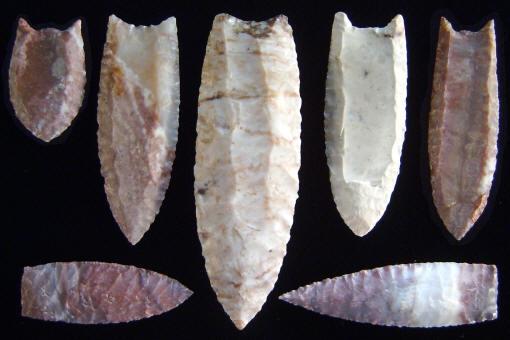
CLICK ON PICTURE FOR LARGER IMAGE
POINTS MADE BY MARVIN McCORMICK
All of these points were made by Marvin McCormick and purchased from
Marvin by Charley Shewey. Charley kept them in a small frame marked
"Marvin McCormick" along with a letter from Marvin. These points
show Marvin's unique flintknapping abilities at a time when very few
people in the world were capable of doing these types of flake removal
techniques. The four smaller points in the top row are examples of
his famous Folsom points. The large point in the center has
"Cochise" written on the other side which is closer to a Clovis but
he might also have called it a Yuma. The two bottom points
illustrate Marvin's pressure flaking abilities. The point on the
left has very well done parallel oblique pressure flaking and fine
edge retouch. All of these points are made of Alibates. The largest
point measures 3 3/16 inches (8.1 cm) long. |
|
|
Marvin McCormick told Charley Shewey, who was also a knapper and
collector, that he made fourteen points a day, five days a week. If
that's true, he would have produced well over 150,000 points in forty
years. One story claims that a dealer in Austin, Texas once ordered five
thousand points at one time from McCormick. Another exaggerated
description of the numbers claims he produced "hundreds of thousands,"
or "boxcar loads." Marvin McCormick's points can be found in private and
institutional collections across the country. So there is good evidence
that he was a very prolific knapper. |
|
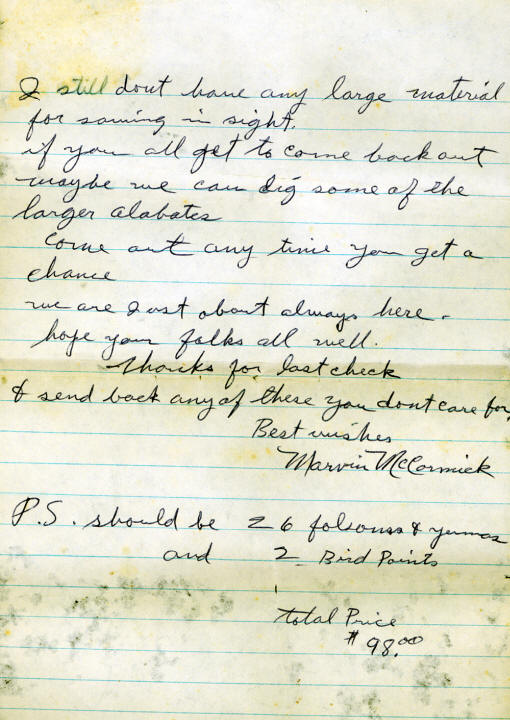
CLICK ON LETTER TO SEE ALL THREE PAGES
PAGE 3 OF A LETTER WRITTEN
BY
MARVIN McCORMICK TO CHARLEY SHEWEY
This is page three of a three page letter that was written to
Charley Shewey from Marvin McCormick and it's dated June 13, 1962.
It's interesting for Marvin's comment that he is having trouble
finding large pieces of Alibates and for the fact that he is using a
saw to cut the material. Marvin is also offering Charley Shewey "26
Folsoms and Yumas and 2 bird points" for a price that works out to
$3.50 each. Charley Shewey was also a flintknapper and one of the
earliest collectors of modern points. Marvin was probably looking
for larger pieces of Alabates so he could make larger points that
Charley would like to buy.
On page one, Marvin also writes about the
problems he was having heat treating some quartzite. Plus he
mentions that he had gone to what would have been the "Stone Age
Fair" in Loveland, Colorado where collectors have been displaying
since 1940. |
|
|
Charley Shewey,
who this writer knew very well, was friends with Marvin McCormick before
WWII. Charley said Marvin worked as a cowboy in those early years in
southeast Colorado around Pritchett. He learned where the sites were and
he and his wife collected and sold the points they found for a few
pennies each. A good three inch side-notched point would bring ten cents
but a Clovis or Agate Basin point would go for fifty cents. Collecting
and selling old points is how most of the early knappers began, prior to
their career of manufacturing new points. |
|
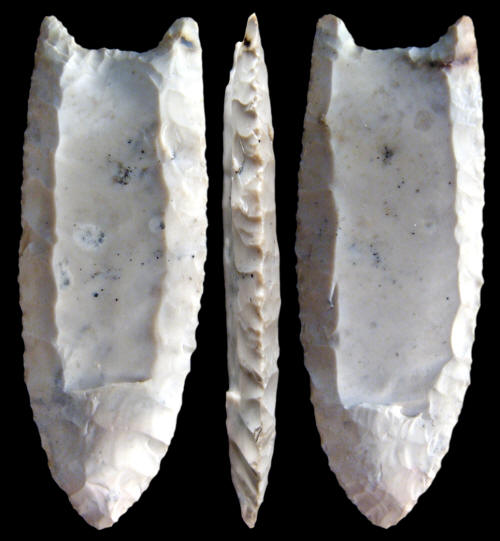
CLICK ON PICTURE FOR LARGER IMAGE
A MARVIN McCORMICK FOLSOM
POINT
ALIBATES
This Marvin McCormick Folsom point has large wide
flutes on both sides. Both flutes stop abruptly with a hinge
fracture approximately 5/8 of an inch (1.6 cm) from the tip of the
point. Marvin fluted his points with either a metal punch or a lever
device. One picture shows him striking a metal punch that is laying
against an isolated platform, with a discoidal shaped stone. The
edges of this point are nicely trimmed with pressure flaking. This
point measures 2 1/4 inches (5.8 cm) long. |
|
|
Marvin McCormick liked to use Alibates. Most of his points were made of
this material. The main source area for Alibates was south of where he
lived in the Texas Panhandle. Alibates is referred to as Alibates flint,
Alibates chert, Alibates agate and agatized dolomite. In an old letter
to Charley Shewey, Marvin comments "If you all get to come back out
maybe we can dig some of the larger Alibates." |
|
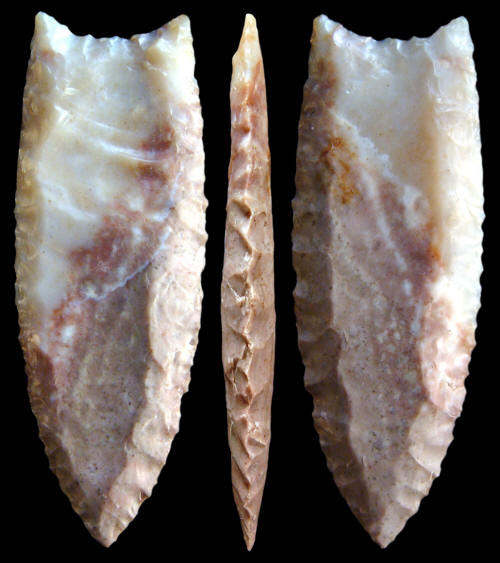
CLICK ON PICTURE FOR LARGER IMAGE
A MARVIN McCORMICK FOLSOM
POINT
ALIBATES
This red and white
Alibates Folsom point was made by Marvin McCormick, probably
sometime in the early 1960's. It has long wide flutes that extend to
the end of the point, which is the "classic" form of Folsom fluting.
The edges were nicely trimmed with pressure. Marvin used a nail that
he fitted into a short half inch dowel for his pressure flaker. This
point measures 2 3/8 inches (6 cm) long. |
|
|
Marvin McCormick
was one of the few early modern knappers who heat treated stone.
According to Charley Shewey he may have learned the process from his
great uncle. Not all flintknapping materials need to be heat treated.
But the fracturing quality of Alibates can be enhanced by heating it to
between 400 and 500 degrees Fahrenheit for approximately ten hours.
Besides making the stone easier to flake, heat treating can also make it
more glossy and more colorful. |
|
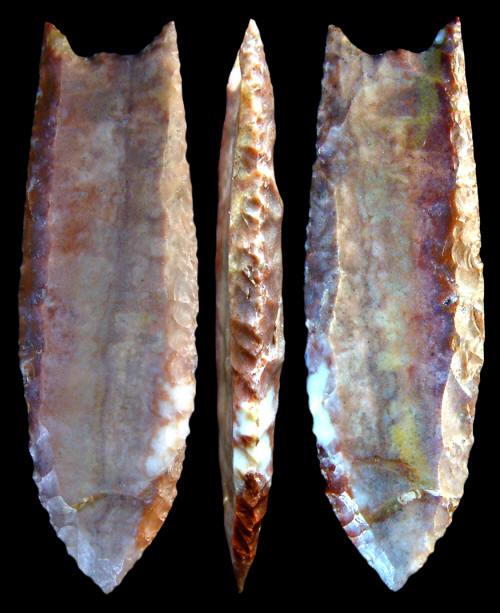
A MARVIN McCORMICK FOLSOM
POINT
ALIBATES
Alabates was Marvin McCormick's favorite material to make Folsom
points. This Alibates Folsom is fluted to the tip of the point on
both sides. It has a small remnant of the original striking platform
still evident in the center of the base. This point measures 2 5/16
inches (5.9 cm) long |
|
|
According to Charley Shewey, Marvin McCormick learned to flint knap from
his great uncle. His great uncle was supposed to have been a teamster
who used ox-drawn freight wagons on the the Santa Fe Trail. If this is
all true, the great uncle might have learned a basic technique of how to
shape a stone point from local Indians. |
|
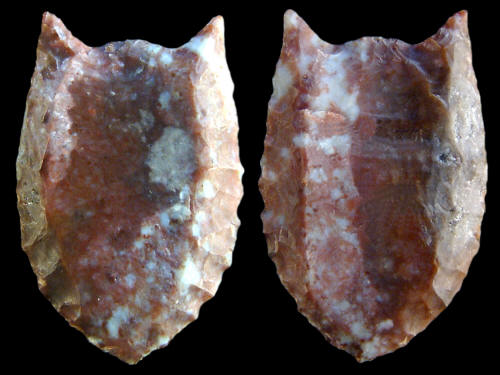
A MARVIN McCORMICK FOLSOM
POINT
ALIBATES
This "classic" looking small Folsom
point was made by Marvin McCormick. Its short and wide shape gives
it an appearance that suggests it was once longer and was
resharpened down to its current size. This Folsom point is fluted to
the tip of the point on both sides and a portion of the flute
striking platform is still evident on the base. This point measures
1 5/16 inches (3.3 cm) long. |
|
|
Marvin McCormick used very simple tools to make his points. He shaped
his preforms with a simple bolt that is referred to as a "plow bolt."
Charley said Marvin struck off flakes using the center of the bolt that
eventually wore down to an hourglass shape. Charley claimed to have
tried to teach Marvin a better way to do percussion flaking but Marvin
evidently continued to use the bolt. |
|
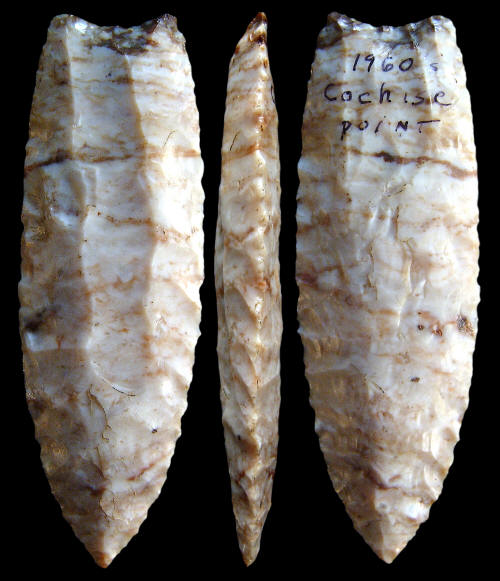
CLICK ON PICTURE FOR LARGER IMAGE
A MARVIN McCORMICK
"COCHISE" POINT
ALIBATES
This point, and all the other points illustrated in this report,
were purchased from Marvin McCormick by Charley Shewey. The writing
on this point was probably put on by Charley, since it's dated
1960's. The term Cochise, in reference to fluted points, has been
used more by collectors over the last fifty years than by anyone
else. Wormington's 1957 book, "Ancient Man In North America,"
describes a Cochise culture but not a Cochise fluted point. The
Cochise point was popularized in 1974 with Van Buren's book
"Arrowheads And Projectile Points," but unfortunately the
illustrated points were most probably not ancient. So the writing on
this Marvin McCormick point suggests it to be one of the
mythological "Cochise points." It looks just like the examples in
Van Buren's book. They all have shallow concave bases, excurvate
sides, and long narrow flutes that are one third or less the length
of the point. This point measures 3 1/4 inches (8.3 cm) long. |
|
|
Marvin McCormick tried different ways to flute his points. He said that
percussion (indirect) produced the thinnest and best Folsom points but
the failure rate was to high. So he developed a lever device that
could press off the channel flakes with pressure. This process produced
Folsom points that were a little thicker but this technique proved to be
more successful from an economical point of view. He could make more
points with less breakage. |
|
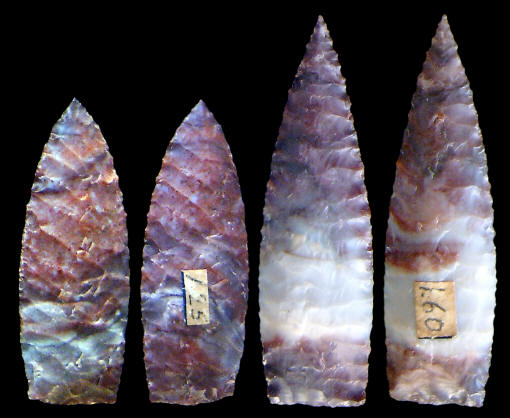
CLICK ON PICTURE FOR LARGER IMAGE
UNIFORMLY PRESSURE FLAKED
POINTS
BY MARVIN McCORMICK
ALIBATES
This picture shows both sides of two points made by Marvin
McCormick. They illustrate Marvin's skill at pressure flaking and
the fact that he wasn't only making fluted points. The point on the
left is especially nice with parallel oblique flaking. Charley
Shewey describes Marvin McCormick's technique at removing pressure
flakes by using an upward motion rather than the commonly used
downward pressure technique. Both of these points still have their
old $1.25 and $1.60 price tags on them. Both of these points are
made of Alibates and the longer point measures 2 1/4 inches (5.7 cm)
long. |
|
|
According to Tony Baker, who met Marvin McCormick sometime in the late
1970's, Marvin told him that he never had a job. Jobs were
few-and-far-between during the depression years and so flintknapping was
how he made his living. So it would seem that the pressures of hard
economic times was apparently the main reason that caused a cowboy from
southeastern Colorado to reinvent Folsom. He certainly made more Folsom
points than anyone else----maybe more than anyone who ever lived. |
|
"REFERENCES"
1962, McCormick, Letter to Charley
Shewey.
1998, Waldorf, Dave, "An Interview With Charley Shewey," Chips,
Vol. 10, #3, p. 12.
2004, Whittaker, John C., "American Flintknappers," p. 49.
2008, Baker, Tony, "Marvin McCormick, The First modern Fluter,"
(from Tony Baker's web site www.ele.net), p. 1.
|
|
RECENT LISTINGS HOME
ORDERING |